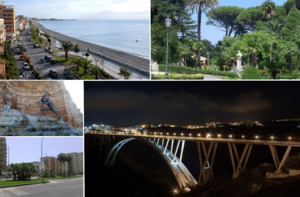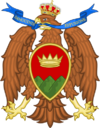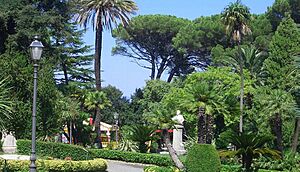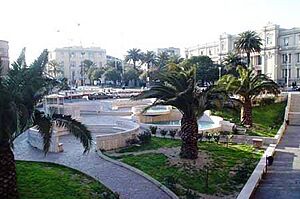Catanzaro facts for kids
Catanzaro (pronounced Kah-tahn-ZAH-roh) is a cool Italian city with about 86,000 people. It's the capital of the Calabria region and is often called the "City of the two Seas" because it's located between the Ionian Sea and the Tyrrhenian Sea.
This city is also known as the "City of the three V's." These V's stand for:
- Saint Vitalian: The city's special patron saint.
- Velvet: Catanzaro was famous for making silk and velvet since ancient times.
- Wind: Strong breezes blow through the city from the Ionian Sea and the Sila mountains.
Catanzaro is home to the "Magna Græcia" University, which is the second-biggest university in Calabria. During summer, the nearby Ionian coast is a popular spot for tourists, especially young people, with many fun places to visit.
Quick facts for kids
Catanzaro
Catanzaru (Sicilian)
|
|||
|---|---|---|---|
| Comune di Catanzaro | |||

Panorama of Catanzaro, Top left: Panorama view of Crotone Street and Ionian Sea at Catanzaro Lido, Top right: Statue of Bernardino Grimaldi in Margheria Park (Villa Margheria), Bottom upper left: Cavatore Fountain in Matteotti Square (Piazza Matteotti), Bottom lower left: Filippos Avenue (Viale de Filippis), Bottom right: Night view of Morandi Viaduct Bridge
|
|||
|
|||
| Country | Italy | ||
| Region | Calabria | ||
| Province | Catanzaro (CZ) | ||
| Area | |||
| • Total | 102.3 km2 (39.5 sq mi) | ||
| Highest elevation | 342 m (1,122 ft) | ||
| Lowest elevation | 0 m (0 ft) | ||
| Population
(2020)
|
|||
| • Total | 86,186 | ||
| • Density | 842.5/km2 (2,182.0/sq mi) | ||
| Demonym(s) | Catanzaresi | ||
| Time zone | UTC+1 (CET) | ||
| • Summer (DST) | UTC+2 (CEST) | ||
| Postal code |
88100
|
||
| Dialing code | 0961 | ||
| Patron saint | St. Vitalian of Capua and St. Agatius (co-patron) | ||
| Saint day | July 16 | ||
Contents
Geography and Climate
Catanzaro sits on hills overlooking the Gulf of Squillace in the Ionian Sea. The city center is about 300 meters (984 feet) above sea level. It's unique because it's close to the sea but also gets snow in winter!
Catanzaro's Weather
The city has a typical Mediterranean climate. This means it has mild winters and warm, dry summers. Spring and autumn are often windy.
The average temperature in January, the coldest month, is about 8.9°C (48°F). August, the hottest month, averages around 24.5°C (76°F). The wind is a big part of Catanzaro's weather, especially in spring and autumn.
The city gets about 1,000 mm (39 inches) of rain each year, mostly in autumn and winter. Summers are usually dry.
A Look Back in Time: Catanzaro's History
Catanzaro has a very long history! Some people think it started as an ancient Greek settlement. Others believe it grew from smaller villages in the area.
Archaeologists have found signs that people lived here since the Iron Age. They even found a Greek burial ground from the 5th century BC and an ancient Roman settlement.
How Catanzaro Got Its Name
One story says Catanzaro was named after two Byzantine generals, Cattaro and Zaro. They led a coastal city and moved it to a safer, higher spot, which became Catanzaro.
Another idea is that the name comes from the Greek word "Katartárioi," meaning "spinners of silk." This makes sense because silk production was very important here.
Silk City
Catanzaro became a major center for silk production in Italy between the 9th and 11th centuries. Its silk was so good that it was sold all over Europe, including Spain, Venice, and the Netherlands. The city was known for its amazing silks, velvets, and other fancy fabrics.
In the 15th century, the King of France, Louis XI, even invited silk weavers from Catanzaro to Lyon to teach their special techniques. One of these weavers, Jean le Calabrais, invented an early version of a special loom that could work threads faster and more precisely.
By 1519, the Holy Roman Emperor Charles V officially recognized Catanzaro's silk industry. He allowed the city to create a "consulate of the silk craft" to manage and check the quality of silk production. At its peak, the city had over 500 looms, and by 1660, about 5,000 people were working in the silk industry!
Important Moments
- Saracen Control: Around 903 AD, the city was taken over by the Saracens, who called it Qaṭanṣār.
- Norman Conquest: In 1069, after a long fight, Catanzaro was captured by the Normans led by Robert Guiscard. They built the Norman castle, which you can still see parts of today.
- Royal City: Over the centuries, different powerful families and kings ruled Catanzaro. Emperor Frederick II made it a direct possession of the crown in the 13th century.
- Imperial Eagle: In 1528, Emperor Charles V gave Catanzaro the right to add the imperial eagle to its coat of arms, showing how important the city was.
- Capital of Calabria: In 1970, Catanzaro was chosen to be the capital city of the Calabria region.
Past Names of Catanzaro
Catanzaro has had several names throughout its history:
- Katantzárion: An ancient Greek name.
- Chatacium: During Roman times.
- Qaṭanṣār: The name given by the Saracens.
- Rock of Niceforo: From the Byzantine period.
- Cathacem: During the Norman period.
- Cathanzario: Under the Kingdom of Naples.
- Catanzaro: Its current name under united Italy.
Cool Places to See
- Catanzaro Bridge: Also known as the Morandi-Bisantis Viaduct, this is a famous bridge with one arch. It's one of the tallest bridges in Europe!
- Duomo (Cathedral): This big church was first built by the Normans in 1121. It was damaged in World War II but has been rebuilt.
- Basilica dell'Immacolata: Another important church in the city.
- Church of the Santissimo Rosario: This church holds amazing silk fabrics made between the 1500s and 1800s.
- Church of Sant'Omobono: A small Byzantine church from the 11th century.
- Remains of the Norman Castle: You can still see parts of the castle built by the Normans.
- Palazzo de' Nobili: This old palace from the 15th century is now the Town Hall.
- Piazza Grimaldi: A town square named after the Grimaldi family, who were important traders in Catanzaro.
Population Over Time
| Historical population | |||||||||||||||||||||||||||||||||||||||||||||||||||||||
|---|---|---|---|---|---|---|---|---|---|---|---|---|---|---|---|---|---|---|---|---|---|---|---|---|---|---|---|---|---|---|---|---|---|---|---|---|---|---|---|---|---|---|---|---|---|---|---|---|---|---|---|---|---|---|---|
|
|
||||||||||||||||||||||||||||||||||||||||||||||||||||||
| Source: ISTAT | |||||||||||||||||||||||||||||||||||||||||||||||||||||||
Economy
Today, Catanzaro's economy is mostly based on services, like shops, offices, and tourism. There are also many small and medium-sized businesses that serve the local area.
Getting Around Catanzaro
Catanzaro has a state road (SS106 Jonica) that connects it to a major motorway (A2).
The city also has a local train line with three stations. A special metropolitan train service helps people get around, with 11 stations in the city and more in nearby towns. There are also 49 bus lines. The city has two main train stations: Catanzaro and Catanzaro Lido.
Sports
The city's football (soccer) team is called U.S. Catanzaro 1929. They play their home games at the Stadio Nicola Ceravolo.
Famous People from Catanzaro
- Renato Dulbecco: A scientist who won the Nobel prize.
- Mimmo Rotella: A modern artist who invented a style called Décollage.
- Filippo De Nobili: A writer, poet, and historian.
See also
 In Spanish: Catanzaro para niños
In Spanish: Catanzaro para niños






